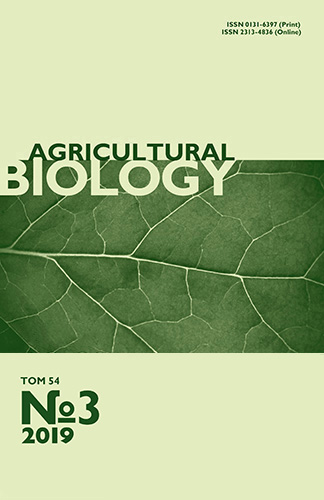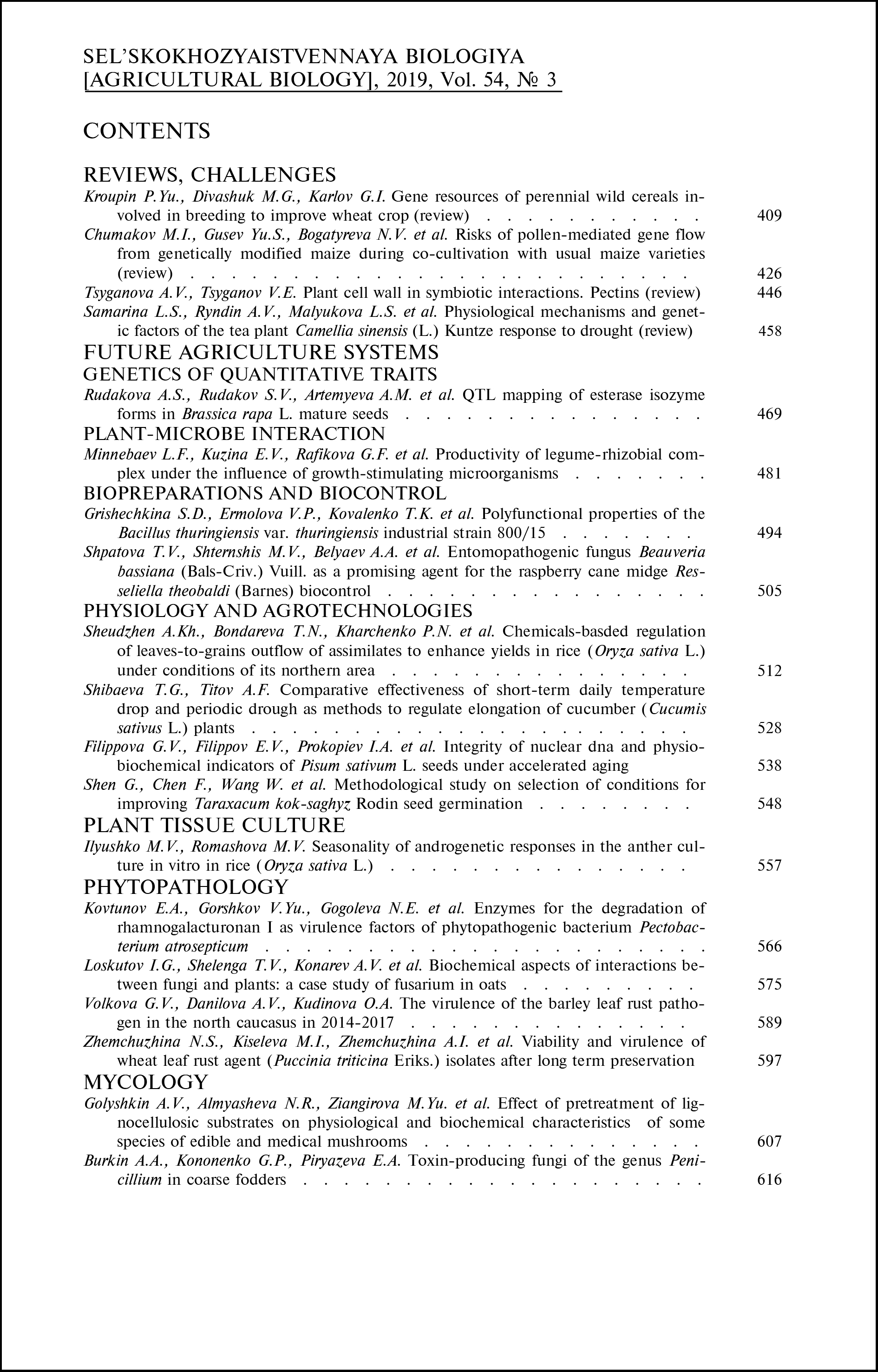doi: 10.15389/agrobiology.2019.3.481eng
UDC: 633.31/.37:631.8:631.461.5:581.1
Acknowledgements:
In this work, the equipment of the BioAnalit Collective Use Center of the UIB UFIC RAS was used.
PRODUCTIVITY OF LEGUME-RHIZOBIAL COMPLEX UNDER THE INFLUENCE OF GROWTH-STIMULATING MICROORGANISMS
L.F. Minnebaev1, E.V. Kuzina1, G.F. Rafikova1, I.O. Chanyshev2,
O.N. Loginov1
1Ufa Institute of Biology — Subdivision of the Ufa Federal Research Centre RAS, 69, Prosp. Oktyabrya, Ufa, 450054 Russia, e-mail linar00711@gmail.com, misshalen@mail.ru, rgf07@mail.ru, biolab316@yandex.ru (✉ corresponding author);
2Bashkir Research Institute of Agriculture — Subdivision of the Ufa Federal Research Centre RAS, 19, ul. Rikharda Zorge, Ufa, 450059 Russia, e-mail chanyshev.io@bashkortostan.ru
ORCID:
Minnebaev L.F. orcid.org/0000-0001-7332-1348
Chanyshev I.O. orcid.org/0000-0002-1463-3250
Kuzina E.V. orcid.org/0000-0002-6905-0108
Loginov O.N. orcid.org/0000-0002-7367-2970
Rafikova G.F. orcid.org/0000-0001-7655-5588
Received October 31, 2018
The lack of a general transition to environmentally oriented (environmentally friendly) agriculture is primarily due to the fact that use of biologicals shows unstable effects. An impact of the introduced microorganisms on the native soil microbiota, in particular, on natural microbial-plant relations, remains little studied. The purpose of this work was to study the effect of growth-stimulating strains of Paenibacillus ehimensis IB 739, Pseudomonas koreensis IB-4 and Ps. chlororaphis IB-51 on the legume plant—an aboriginal microbial community ecosystem. Seeds of pea (Pisum sativum L.) variety Chishminsky 95, white lupine (Lupinus albus L.) variety Dega, chickpea (Cicer arietinum L.) variety Zavolzhsky, alfalfa changeable (Medicago × varia Martyn) variety Galia, white melilot (Melilotus albus Medik.) variety Chermasan were treated with liquid cultures of rhizosphere bacteria strains. Sterile tap water was the control, and well-known microbiological fertilizer Azotovit® based on Azotobacter chroococcum B-9029 strain was the standard. Seed germination percentage, plant size, the number of root nodules, root rot lesions, nitrogen accumulation in the soil and nitrogen assimilation by plants, and abundance of inoculants in the soil served as estimates of the effect of seed inoculation during 45-day pot experiment carried out under room temperature and natural lighting. Plants, along with the soil samples for counting inoculants, were collected on day 18 and day 45, the samples for assessing nitrogen accumulation were collected on day 45. The obtained data indicate the stimulating effect of strains P. ehimensis IB 739, Ps. koreensis IB-4, and Ps. chlororaphis IB-51 on the formation and function of various legume-rhizobial communities. Treatment with plant growth-promoting (PGP) microorganisms improved seed germination, plant growth and development. In seed treating with Ps. chlororaphis IB-51, the root length predominantly increased, whereas Ps. koreensis IB-4 strain stimulated the development of the aerial parts. The Ps. chlororaphis IB-51 and Ps. koreensis IB-4 were most effective on pea, lupine and chickpea plants with no growth stimulation on alfalfa and melilot plants The inoculation of seeds with tested bacterial strains was found to suppress of the development of microscopic fungi in the rhizosphere, as a result, the root rot on peas decreased from 66.7 % to 25.3-43.8 %, on lupine from 35.9 % to 20.3-25.0 %. The inoculants showed no inhibitory effect on rhizobia, on the contrary, nodulation became more abundant. After seed bacterization of fodder crops with P. ehimensis IB 739, the number of nodules on the roots increased 1.9-2.6 times. P. ehimensis IB 739 proved to be the most active in providing accumulation of nitrogen in plants and in the soil. The nitrogen concentration in the treated pea plants was 8.5 % vs. 3.9 % in the control, in lupine — 8.6 % vs. 5.0 % in the control. To summarize, the growth-promoting properties of a strain do not guarantee its favorable effect on the productivity of leguminous plants. Strains having similar characteristics can significantly differ in their effectiveness on the same legume crops.
Keywords: PGPB, Pseudomonas, Paenibacillus, leguminous plants, growth-promoting activity, nodule formation, nitrogen fixation, plant-microorganism interaction.
REFERENCES
- Sziderics A.H., Rasche F., Trognitz F., Sessitsch A., Wilhelm E. Bacterial endophytes contribute to abiotic stress adaptation in pepper plants (Capsicum annuum L.). Canadian Journal of Microbiology, 2007, 53(11): 1195-1202 CrossRef
- Joo G.J., Kim Y.M., Kim J.T., Rhee I.K., Kim J.H., Lee I.J. Gibberellins-producing rhizobacteria increase endogenous gibberellins content and promote growth of red peppers. Journal of Microbiology, 2005, 43(6): 510-515.
- Yang J., Kloepper J.W., Ryu C.M. Rhizosphere bacteria help plants tolerate abiotic stress. Trends in Plant Science, 2009, 14(1): 1-4 CrossRef
- Forchetti G., Masciarelli O., Alemano S., Alvares D., Abdala G. Endophytic bacteria in sunflower (Helianthus annuus L.): isolation, characterization, and production of jasmonates and abscisic acid in culture medium. Applied Microbiology and Biotechnology, 2007, 76(5): 1145-1152 CrossRef
- Francis I., Holsters M., Vereecke D. The Gram-positive side of plant-microbe interactions. Environmental Microbiology, 2010, 12(1): 1-12 CrossRef
- van Loon L.C. Plant responses to plant growth-promoting rhizobacteria. European Journal of Plant Pathology, 2007, 119(3): 243-254 CrossRef
- Berg G. Plant—microbe interactions promoting plant growth and health: perspectives for controlled use of microorganisms in agriculture. Applied Microbiology and Biotechnology, 2009, 84(1): 11-18 CrossRef
- Raaijmakers J.M., Paulitz T.C., Steinberg C., Alabouvette C., Möenne-Loccoz Y. The rhizosphere: a playground and battlefield for soilborne pathogens and beneficial microorganisms. Plant and Soil, 2009, 321(1-2): 341-361 CrossRef
- Chandrashekhara, Niranjanranj S., Deepak S.A., Amrutesh K.N., Shetty N.P., Shetty H.S. Endophytic bacteria from different plant origin enhance growth and induce downy mildew resistance in pearl millet. Asian Journal of Plant Pathology, 2007, 1(1): 1-11 CrossRef
- Walters D.R., Fountaine J.M. Practical application of induced resistance to plant diseases: an appraisal of effectiveness under field conditions. The Journal of Agricultural Science, 2009, 147(5): 523-535 CrossRef
- Spaepen S., Vanderleyden J., Remans R. Indole-3-acetic acid in microbial and microorganism-plant signaling. FEMS Microbiology Reviews, 2007, 31(4): 425-448 CrossRef
- Gouws L.M., Botes E., Wiese A.J., Trenkamp S., Torres-Jerez I., Tang Y., Hills P.N., Usadel B., Lloyd J.R., Fernie A.R., Kossmann J., van der Merwe M. The plant growth promoting substance, lumichrome, mimics starch, and ethylene-associated symbiotic responses in lotus and tomato roots. Front. Plant Sci., 2012, 3: 120 CrossRef
- Khan W., Prithiviraj B., Smith D.L. Nod factor [Nod Bj V (C18:1, MeFuc)] and lumichrome enhance photosynthesis and growth of corn and soybean. Journal of Plant Physiology, 2008, 165(13): 1342-1351 CrossRef
- Hemissi I., Mabrouk Y., Abdi N., Bouraoui M., Saidi M., Sifi B. Effects of some Rhizobium strains on chickpea growth and biological control of Rhizoctonia solani. African Journal of Microbiology Research, 2011, 24(5): 4080-4090 CrossRef
- Akhtar M.S., Shakeel U., Siddiqui Z.A. Biocontrol of Fusarium wilt by Bacillus pumilis, Pseudomonas alcaligenes and Rhizobium sp. on lentil. Turk. J. Biol., 2010, 34: 1-7 CrossRef
- Loginov O.N., Chetverikov S.P., Davletshin T.K., Kuzina E.V. Shtamm azotfiksiruyushchikh bakterii Pseudomonas sp. dlya polucheniya biopreparata protiv zabolevanii pshenitsy, vyzyvaemykh fitopatogennymi gribami, i povysheniya urozhainosti. Patent RF № 2529958. Zayavl. 20.08.2013. Opubl. 10.10.2014. Byul. № 28 [The strain of nitrogen-fixing bacteria Pseudomonas sp. for obtaining a biological product against wheat diseases caused by pathogenic fungi, and increasing yields. Patent RF № 2529958. Claims 20.08.2013. Publ. 10.10.2014. Bul. № 28] (in Russ.).
- Rafikova G.F., Korshunova T.Yu., Minnebaev L.F., Chetverikov S.P., Loginov O.N. Mikrobiologiya, 2016, 85(3): 317-326 CrossRef (in Russ.).
- Khudaigulov G.G., Loginov O.N., Melent'ev A.I. Izvestiya Samarskogo nauchnogo tsentra Rossiiskoi akademii nauk, 2011, 5: 214-217 (in Russ.).
- Boronin A.M. Sorosovskii obrazovatel'nyi zhurnal, 1998, 10: 25-31 (in Russ.).
- Ivanchina N.V., Garipova S.R. Agrokhimiya, 2012, 7: 87-95 (in Russ.).
- Melent'ev A.I. Aerobnye sporoobrazuyushchie bakterii Bacillus Cohn v agroekosistemakh [Aerobic spore-forming bacteria Bacillus Cohn in agroecosystems]. Moscow, 2007 (in Russ.).
- Loginov O.N. Bakterii Pseudomonas i Azotobacter kak ob"ekty sel'skokhozyaistvennoi biotekhnologii [Bacteria Pseudomonas and Azotobacter as objects of agricultural biotechnology]. Moscow, 2005 (in Russ.).
- Spirina V.Z., Solov'eva T.P. Agrokhimicheskie metody issledovaniya pochv, rastenii i udobrenii [Agrochemical methods for studying soils, plants and fertilizers]. Tomsk, 2014 (in Russ.).
- Kuz'mina L.Yu. Issledovanie vzaimodeistvii bakterii-antagonistov s rasteniyami i fitopatogennymi gribami. Avtoreferat kandidatskoi dissertatsii [Study of the interactions of antagonist bacteria with plants and phytopathogenic fungi. PhD Thesis]. Kazan', 1998 (in Russ.).
- Smirnov V.V., Kiprianova E.A. Bakterii roda Pseudomonas [Pseudomonas sp. bacteria]. Kiev, 1990 (in Russ.).
- Metodicheskie ukazaniya po gosudarstvennym ispytaniyam fungitsidov, antibiotikov i protravitelei semyan sel'skokhozyaistvennykh kul'tur [Guidelines for State trials of fungicides, antibiotics and seed treaters of agricultural crops]. Moscow, 1985 (in Russ.).
- Dzerzhinskaya I.S. Pitatel'nye sredy dlya vydeleniya i kul'tivirovaniya mikroorganizmov [Nutrient media for isolation and cultivation of microorganisms]. Astrakhan', 2008 (in Russ.).
- Long H.H., Furuya N., Kurose D., Takeshita M., Takanami Y. Isolation of endophytic bacteria from Solanum sp. and their antibacterial activity against plant pathogenic bacteria. Journal of the Faculty of Agriculture, Kyushu University, 2003, 48(1-2): 21-28.
- Persello-Cartieaux F., David P., Sarrobert C., Thibaud M.C., Achouak W., Robaglia C., Nussaume L. Utilization of mutants to analyze the interaction between Arabidopsis thaliana and its naturally root-associated Pseudomonas. Planta, 2001, 212(2): 190-198 CrossRef
- Compant S., Reiter B., Sessitch A., Nowak J., Clement C., Barka E.A. Endophytic colonization of Vitis vinifera L. by a plant growth-promoting bacterium Burkholderia sp. strain PsJN. Applied Microbiology and Biotechnology, 2005, 71(4): 1685-1693 CrossRef
- Idris E.E.S., Iglesias D.J., Talon M., Borriss R. Tryptophan-dependent production of indole-3-acetic acid (IAA) affects level of plant growth promotion by Bacillus amyloliquefaciens FZB42. Mol. Plant-Microbe Interact., 2007, 20(6): 619-626 CrossRef
- Veselov S.Yu., Ivanova T.N., Simonyan M.V., Melent'ev A.I. Prikladnaya biokhimiya i mikrobiologiya, 1998, 34(2): 175-179 (in Russ.).
- Kudoyarova G.R., Kurdish I.K., Melent'ev A.I. Izvestiya UNTS RAN, 2011, 3-4: 5-16 (in Russ.).
- Joy S.G., George P. Phytochemical analysis of alfalfa (Medicago sativa) seed extract by soxhlet extraction using different solvents. American Journal of Advanced Drug Delivery, 2014, 2(2): 145-152.
- Garipova S.R., Garifullina D.V., Markova O.V., Ivanchina N.V., Khairullin R.M. Agrokhimiya, 2010, 11: 50-58 (in Russ.).
- Kumari S., Khanna V. Effect of antagonistic rhizobacteria inoculated with Mesorhizobium ciceri on control of fusarium wilt in chickpea (Cicer arietinum L.). African Journal of Microbiology Research, 2014, 8(12): 1255-1265 CrossRef
- Efimov V.N., Vorobeikov G.A., Patil A.B., Miryugina T.A., Bredikhin V.N., Khotyanovich A.V. Agrokhimiya, 1996, 1: 10-15 (in Russ.).
- Ferguson B.J., Mathesius U. Phytohormone regulation of legume-rhizobia interactions. Journal of Chemical Ecology, 2014, 40(7): 770-790 CrossRef
- van Noorden G.E., Ross J.J., Reid J.B., Rolfe B.G., Mathesius U. Defective long-distance auxin transport regulation in the Medicago truncatula super numeric nodules mutant. Plant Physiology, 2006, 140(4): 1494-1506 CrossRef
- Spehn E.M., Scherer-Lorenzen M., Schmid B., Hector A., Caldeira M.C., Dimitrakopoulos P.G., Finn J.A., Jumpponen A., O’Donnovan G., Pereira J.S., Schulze E.D., Troumbis A.Y., Körner C. The role of legumes as a component of biodiversity in a cross-European study of grassland biomass nitrogen. Oikos, 2002, 98: 205-218 CrossRef
- Shabaev V.P. Pochvovedenie, 2010, 4: 471-476 (in Russ.).












